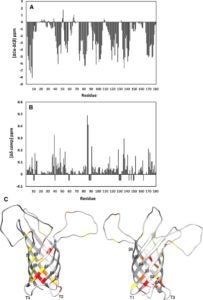Optimizing nanodiscs and bicelles for solution NMR studies of two B-barrel membrane proteins.
Iga Kucharska, Thomas C. Edrington, Binyong Liang, Lukas Tamm.
J Biomol NMR (2015) 61:261-274
DOI 10.1007/s10858-015-9905-z
PubMed: http://www.ncbi.nlm.nih.gov/pubmed/?term=25869397
PMCID: PMC4397663 [Available on 2016-04-01]
The final publication is available at link.springer.com
Abstract: Solution NMR spectroscopy has become a robust method to determine structures and explore the dynamics of integral membrane proteins. The vast majority of previous studies on membrane proteins by solution NMR have been conducted in lipid micelles. Contrary to the lipids that form a lipid bilayer in biological membranes, micellar lipids typically contain only a single hydrocarbon chain or two chains that are too short to form a bilayer. Therefore, there is a need to explore alternative more bilayer-like media to mimic the natural environment of membrane proteins. Lipid bicelles and lipid nano discs have emerged as two alternative membrane mimetics that are compatible with solution NMR spectroscopy. Here, we have conducted a comprehensive comparison of the physical and spectroscopic behavior of two outer membrane proteins from Pseudomonas aeruginosa, OprG and OprH, in lipid micelles, bicelles, and nanodiscs of five different sizes. Bicelles stabilized with a fraction of negatively charged lipids yielded spectra of almost comparable quality as in the best micellar solutions and the secondary structures were found to be almost indistinguishable in the two environments. Of the five nanodiscs tested, nano discs assembled from MSP1D1DH5 performed the best with both proteins in terms of sample stability and spectral resolution. Even in these optimal nanodiscs some broad signals from the membrane embedded barrel were severely overlapped with sharp signals from the flexible loops making their assignments difficult. A mutant OprH that had two of the flexible loops truncated yielded very promising spectra for further structural and dynamical analysis in wMSP1D1DH5 nanodiscs.

